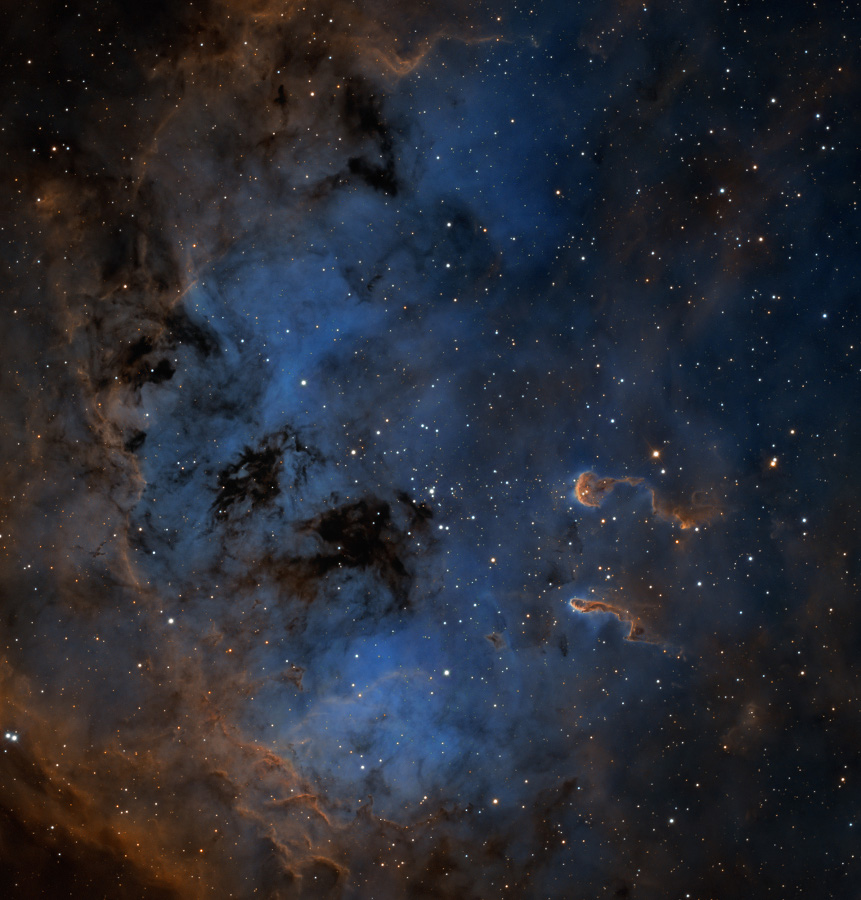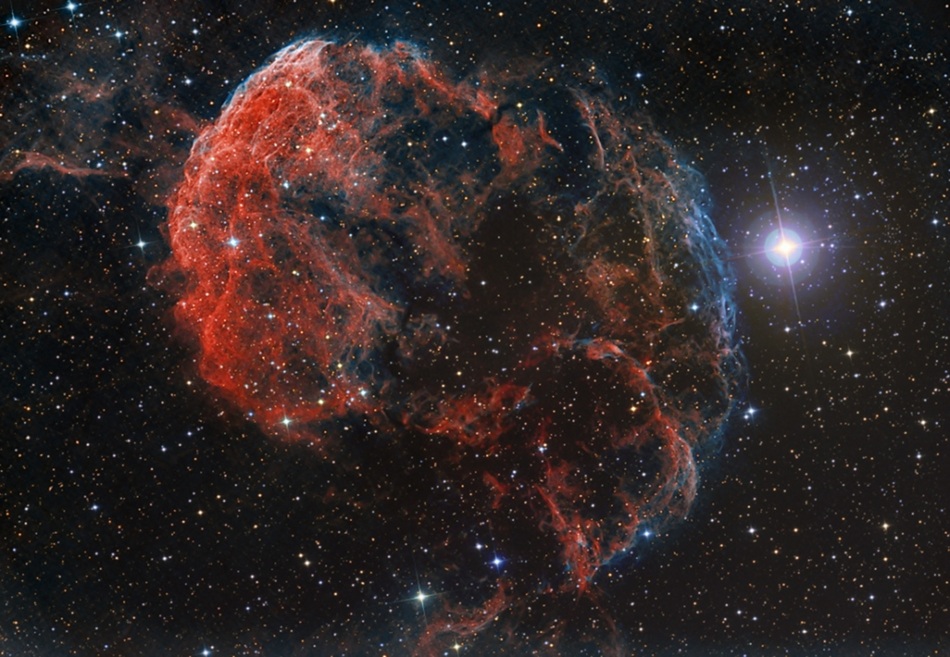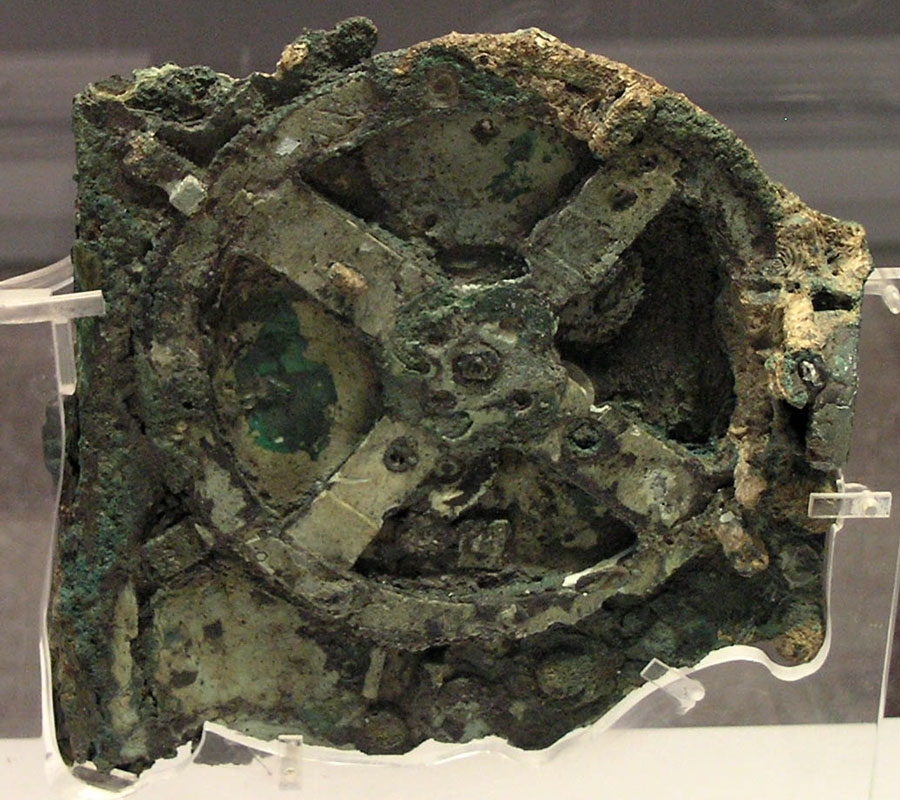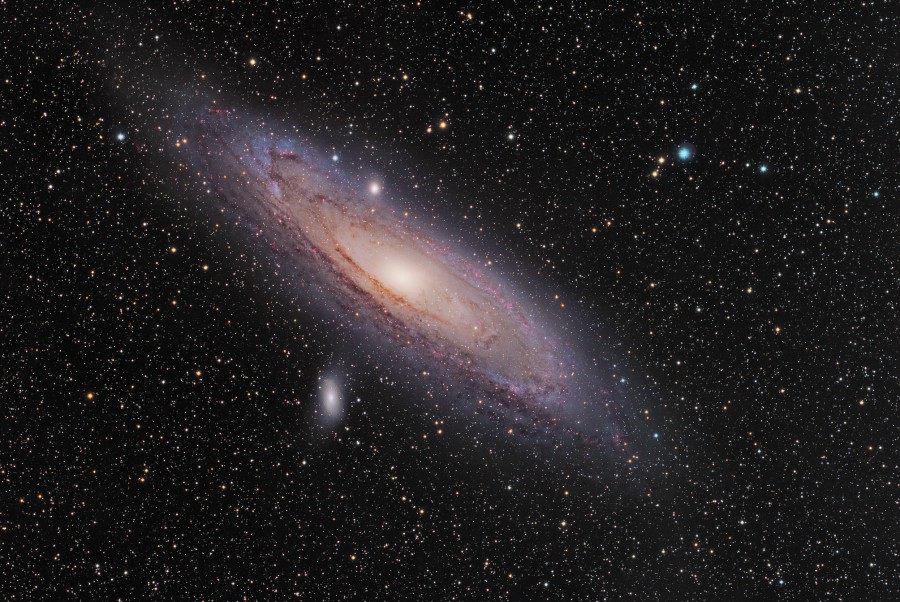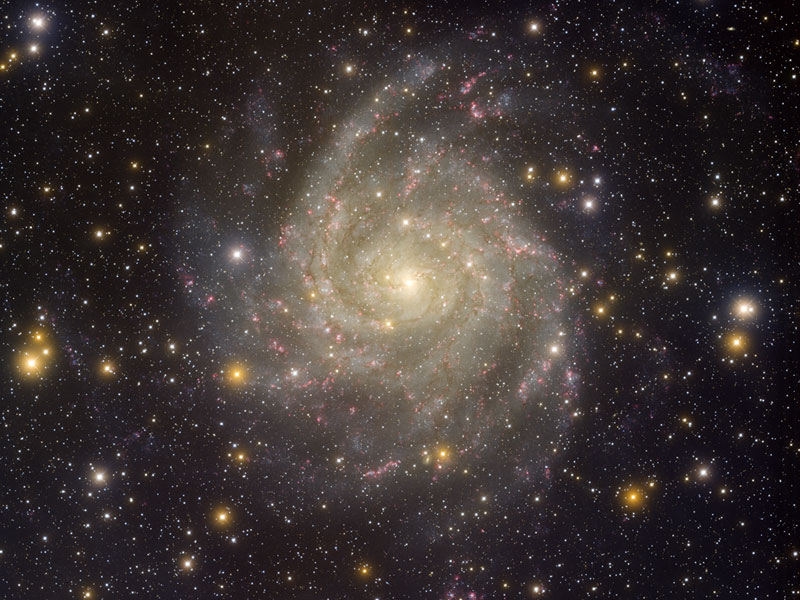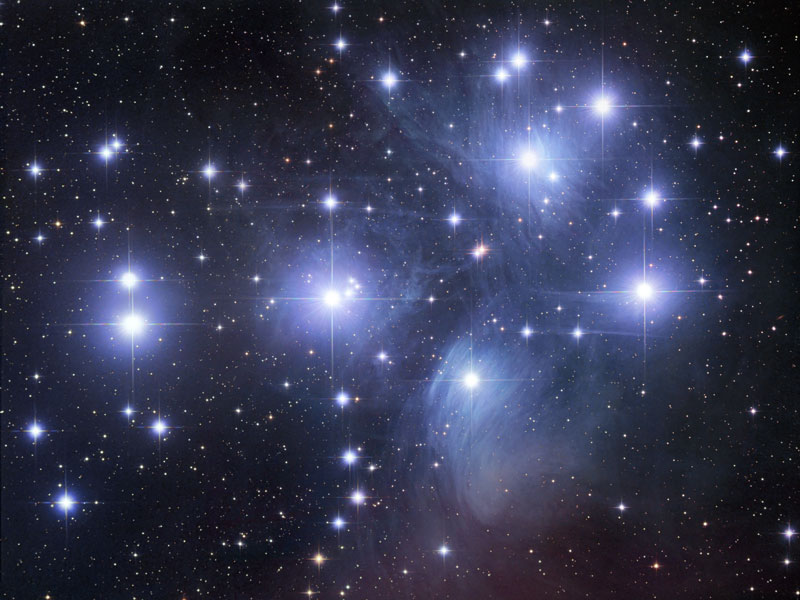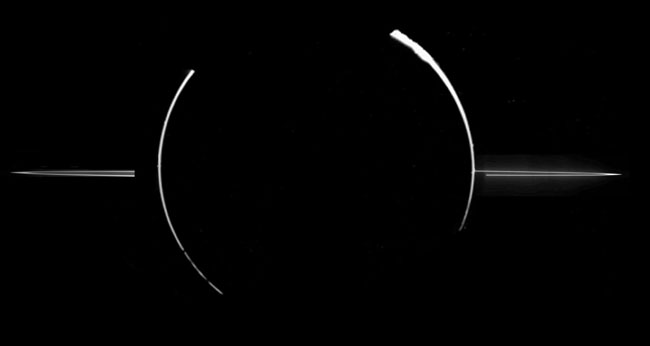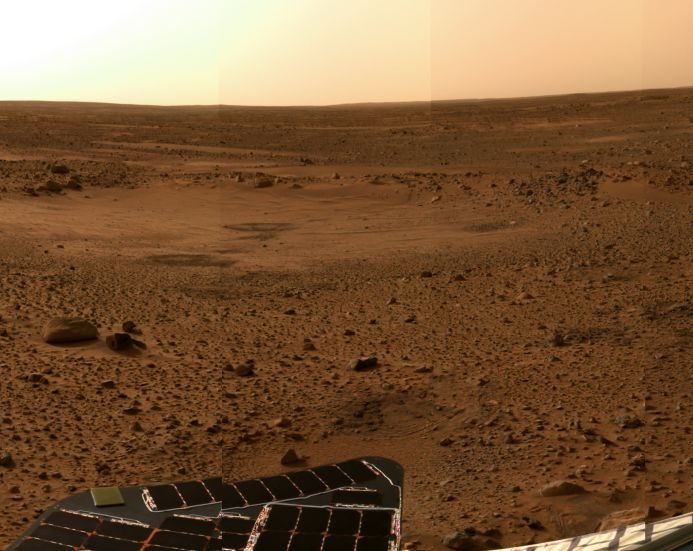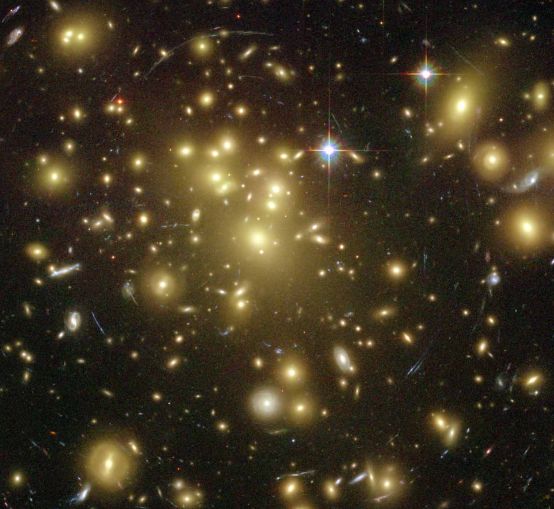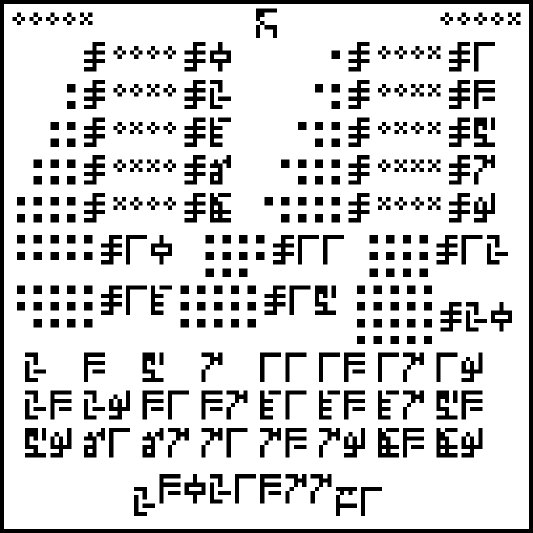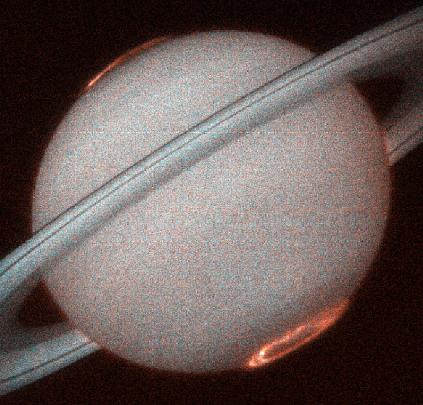| << Previous | Index | Next >> |
2015 Spiral galaxy NGC 1097 shines in southern skies, about 45 million light-years away in the chemical constellation Fornax. Its blue spiral arms are mottled with pinkish star forming regions in this colorful galaxy portrait. They seem to have wrapped around a small companion galaxy below and left of center, about 40,000 light-years from the spiral's luminous core. That's not NGC 1097's only peculiar feature, though. The very deep exposure hints of faint, mysterious jets, most easily seen to extend well beyond the bluish arms toward the left. In fact, four faint jets are ultimately recognized in optical images of NGC 1097. The jets trace an X centered on the galaxy's nucleus, but probably don't originate there. Instead, they could be fossil star streams, trails left over from the capture and disruption of a much smaller galaxy in the large spiral's ancient past. A Seyfert galaxy, NGC 1097's nucleus also harbors a supermassive black hole.
2014 This telescopic close-up shows off the otherwise faint emission nebula IC 410 in striking false-colors. It also features two remarkable inhabitants of the cosmic pond of gas and dust below and right of center, the tadpoles of IC 410. The picture is a composite of images taken through narrow band filters. The narrow band image data traces atoms in the nebula, with emission from sulfur atoms in red, hydrogen atoms in green, and oxygen in blue. Partly obscured by foreground dust, the nebula itself surrounds NGC 1893, a young galactic cluster of stars that energizes the glowing gas. Composed of denser cooler gas and dust the tadpoles are around 10 light-years long, potentially sites of ongoing star formation. Sculpted by wind and radiation from the cluster stars, their tails trail away from the cluster's central region. IC 410 lies some 12,000 light-years away, toward the constellation Auriga.
2013 Normally faint and elusive, the Jellyfish Nebula is caught in this alluring telescopic view. Drifting near bright star Eta Geminorum, at the foot of a celestial twin, the Jellyfish Nebula is seen dangling tentacles from the bright arcing ridge of emission left of center. In fact, the cosmic jellyfish is part of bubble-shaped supernova remnant IC 443, the expanding debris cloud from a massive star that exploded. Light from the explosion first reached planet Earth over 30,000 years ago. Like its cousin in astrophysical waters the Crab Nebula supernova remnant, IC 443 is known to harbor a neutron star, the remnant of the collapsed stellar core. The Jellyfish Nebula is about 5,000 light-years away. At that distance, this image would be about 100 light-years across.
2012 From our vantage point in the Milky Way Galaxy, we see NGC 6946 face-on. The big, beautiful spiral galaxy is located just 10 million light-years away, behind a veil of foreground dust and stars in the high and far-off constellation of Cepheus. From the core outward, the galaxy's colors change from the yellowish light of old stars in the center to young blue star clusters and reddish star forming regions along the loose, fragmented spiral arms. NGC 6946 is also bright in infrared light and rich in gas and dust, exhibiting a high star birth and death rate. In fact, since the early 20th century at least nine supernovae, the death explosions of massive stars, were discovered in NGC 6946. Nearly 40,000 light-years across, NGC 6946 is also known as the Fireworks Galaxy. This remarkable portrait of NGC 6946 is a composite that includes image data from the 8.2 meter Subaru Telescope on Mauna Kea.
2011 What is it? It was found at the bottom of the sea aboard an ancient Greek ship. Its seeming complexity has prompted decades of study, although some of its functions remained unknown. Recent X-rays of the device have now confirmed the nature of the Antikythera mechanism, and discovered several surprising functions. The Antikythera mechanism has been discovered to be a mechanical computer of an accuracy thought impossible in 80 BC, when the ship that carried it sank. Such sophisticated technology was not thought to be developed by humanity for another 1,000 years. Its wheels and gears create a portable orrery of the sky that predicted star and planet locations as well as lunar and solar eclipses. The Antikythera mechanism, shown above, is 33 centimeters high and similar in size to a large book.
2010 The most distant object easily visible to the eye is M31, the great Andromeda Galaxy some two and a half million light-years away. But without a telescope, even this immense spiral galaxy - spanning over 200,000 light years - appears as a faint, nebulous cloud in the constellation Andromeda. In contrast, details of a bright yellow nucleus and dark winding dust lanes, are revealed in this digital telescopic image. Narrow band image data recording emission from hydrogen atoms, shows off the reddish star-forming regions dotting gorgeous blue spiral arms and young star clusters. While even casual skygazers are now inspired by the knowledge that there are many distant galaxies like M31, astronomers seriously debated this fundamental concept in the 20th century. Were these "spiral nebulae" simply outlying components of our own Milky Way Galaxy or were they instead "island universes" -- distant systems of stars comparable to the Milky Way itself? This question was central to the famous Shapley-Curtis debate of 1920, which was later resolved by observations of M31 in favor of Andromeda, island universe.
2009 Large, dusty, spiral galaxy NGC 4945 is seen edge-on near the center of this rich telescopic image. The field of view spans nearly 2 degrees, or about 4 times the width of the Full Moon, toward the expansive southern constellation Centaurus. About 13 million light-years distant, NGC 4945 is almost the size of our own Milky Way Galaxy. But X-ray and infrared observations reveal even more high energy emission and star formation in the core of NGC 4945. The other prominent galaxy in the field, NGC 4976, is an elliptical galaxy. Left of center, NGC 4976 is much farther away, at a distance of about 35 million light-years, and not physically associated with NGC 4945.
2008 Beautiful nearby spiral galaxy IC 342 could be more famous if it wasn't so hidden. A sprawling island universe, IC 342 would be a prominent galaxy in our night sky, but it is almost hidden from view behind the veil of stars, gas and dust clouds in the plane of our Milky Way galaxy. Similar in size to other large, bright spiral galaxies IC 342 is a mere 7 million light-years distant in the long-necked, northern constellation of the Giraffe (Camelopardalis). Even though IC 342's light is dimmed by intervening cosmic clouds, this remarkably sharp telescopic image traces the galaxy's own obscuring dust, blue star clusters, and glowing pink star forming regions along spiral arms that wind far from the galaxy's core. IC 342 may have undergone a recent burst of star formation activity and is close enough to have gravitationally influenced the evolution of the local group of galaxies and the Milky Way.
2007 The brightest comet in decades is unexpectedly now visible. The most optimistic predictions have Comet McNaught (C/2006 P1) shortly becoming one of the brightest comets of the past century. For the next few days, its short tail and bright coma can be spotted with the unaided eye close to the Sun and near the horizon in both evening and morning skies. This dramatic picture of the comet shining through cloudy skies was taken near sunset on January 7 from Bad Mergentheim, Germany.
2006 Perhaps the most famous star cluster on the sky, the Pleiades can be seen without binoculars from even the depths of a light-polluted city. Also known as the Seven Sisters and M45, the Pleiades is one of the brightest and closest open clusters. The Pleiades contains over 3000 stars, is about 400 light years away, and only 13 light years across. Quite evident in the above photograph are the blue reflection nebulae that surround the brighter cluster stars. Low mass, faint, brown dwarfs have also been found in the Pleiades. (Editors' note: The prominent diffraction spikes are caused by the telescope itself and may be either distracting or provide aesthetic enhancement, depending on your point of view.)
2005 Why does Jupiter have rings? Jupiter's rings were discovered in 1979 by the passing Voyager 1 spacecraft, but their origin was a mystery. Data from the Galileo spacecraft that orbited Jupiter from 1995 to 2003 later confirmed that these rings were created by meteoroid impacts on small nearby moons. As a small meteoroid strikes tiny Adrastea, for example, it will bore into the moon, vaporize, and explode dirt and dust off into a Jovian orbit. Pictured above is an eclipse of the Sun by Jupiter, as viewed from Galileo. Small dust particles high in Jupiter's atmosphere, as well as the dust particles that compose the rings, can be seen by reflected sunlight.
2004 A martian Sol - the average martian solar day - is about 39 minutes longer than Earth's familiar 24 hour day. Operating on martian time, the Spirit rover recently sent back this color postcard image, recorded on Sol 5 of its stay on the martian surface. This cropped version of the full, high-resolution mosaic looks north across Gusev crater floor. The smooth-looking, 9 meter wide circular feature dubbed Sleepy Hollow lies at the center of the scene. Within it are round dark markings which may have been left by the lander swaddled in airbags as it bounced across the martian surface. Other examples of disturbances, likely made by the lander's retracting airbags, can be seen in the foreground just beyond Spirit's solar cell covered deck.
2003
2002 Difficult to observe, the momentary green flash above the rising or setting sun has been documented as a phenomenon caused by the atmospheric bending or refraction of sunlight. Like a weak prism, the Earth's atmosphere breaks white sunlight into colors, bending red colors slightly and green and blue colors through increasingly larger angles. When the sky is clear, a green flash just above the sun's edge can sometimes be seen for a second or so, when the sun is close to a distant horizon. A blue flash is even harder to see though, because the atmosphere must be extraordinarily clear to avoid scattering and diminishing the refracted blue sunlight. Still, from a site near Roques de los Muchachos (altitude 2,400 meters) on La Palma in the Canary Islands, astrophotographer Mario Cogo captured this dramatic telescopic image of a blue flash on color film in October of 2001. The image of the setting Sun with large sunspot groups on its surface is heavily distorted by atmospheric layers. A lingering green rim is just visible under the tantalizing blue flash.
2001 If you could send a message to an alien civilization, what would you say? The people from the Cosmic Call project sent the above image as the first page of a longer message. The message was broadcast toward local stars by radio telescope during the summer of 1999. The single-dish, 70 meter diameter telescope is located in Ukraine on the Crimean peninsula near the town of Evpatoria. This first page involves only numbers and so is much easier for puzzle solvers to decode than a more famous message broadcast toward distant star cluster M13 in 1974. (The solution is here.)
2000 Sometimes you can't see the forest for the trees. But if you look closely at the center of the above photograph, you will see a whole spiral galaxy behind the field of stars. Named Dwingeloo 1, this nearby galaxy was only discovered recently (1994) because much of its light was obscured by dust, gas and bright stars of our own Milky Way Galaxy. In fact, all the individually discernible stars in the above photograph are in our Galaxy. Dwingeloo 1 turned out to be a large galaxy located only five times as distant as the closest major galaxy - M31.
1999 On November 17, 1970 the Soviet Luna 17 spacecraft landed the first roving remote-controlled robot on the Moon. Known as Lunokhod 1, it weighed just under 2,000 pounds and was designed to operate for 90 days while guided in real-time by a five person team at the Deep Space Center near Moscow, USSR, Planet Earth. The futuristic looking eight wheeler rode on top of a descent module which extended ramps from both sides offering alternative routes to the surface in case one side was blocked by boulders. Lunokhod 1 actually toured the lunar Mare Imbrium (Sea of Rains) for 11 months in one of the greatest successes of the Soviet lunar exploration program. This Lunokhod's operations officially ceased on October 4, 1971, 14 years after the launch of Sputnik.
1998 Girdling the second largest planet in the Solar System, Saturn's Rings are one of the most spectacular sights for earthbound telescopes. This recently released image, from the orbiting Hubble Space Telescope's STIS instrument, offers a striking view of another kind of ring around Saturn - pole encircling rings of ultraviolet aurora. Towering more than 1,000 miles above the cloud tops, these Saturnian auroral displays are analogous to Earth's. Energetic charged particles in the Solar Wind are funneled by the planet's magnetic field into polar regions where they interact with atmospheric gases. Following the ebb and flow of Saturn's aurora, researchers can remotely explore the planet's atmosphere and magnetic field. In this false color image, the dramatic red aurora identify emission from atomic hydrogen, while the more concentrated white areas are due to hydrogen molecules. In 2004, NASA plans to begin making close-up studies of the Saturnian system with the Cassini Spacecraft.
1997 A dramatic mosaic of recent images from the Galileo spacecraft reveals details of swirling clouds and a thick stratospheric haze in the atmosphere of Jupiter, the Solar System's largest planet. This false color representation is keyed to altitude - red indicates cloud features near the top of the gas giant's extensive atmosphere while blue corresponds to features at depth. North is up in the mosaic, centered at about 50 degrees northern Jovian latitude, and the limb or edge of the planet arcs across the upper right. The line of sight looking toward the limb emphasizes the high altitude, red haze. What causes the red haze? It may well be created as energetic electrons and other charged particles swept up by Jupiter's magnetosphere are funneled along magnetic field lines and bombard the atmosphere near the polar regions. Charged magnetospheric particles can also create Aurora.
1996 The distance to the swirling grand design spiral M100 is causing quite a stir among astronomers. Many believe that the Hubble Space Telescope's recent distance measurement to this galaxy accurately calibrates the expansion rate of the universe. Others believe this distance measurement is misleading. The universe's expansion rate is usually given as a quantity called "Hubble's constant", a factor dividing well-measured recession velocity of a galaxy to give actual distance. Scientific debate over the value of Hubble's constant has been ongoing since it was first measured by Edwin Hubble in 1929. A real live debate involving the value of Hubble's constant titled "The Scale of the Universe" will occur in April 1996 in Washington, DC.
| << Previous | Index | Next >> |

